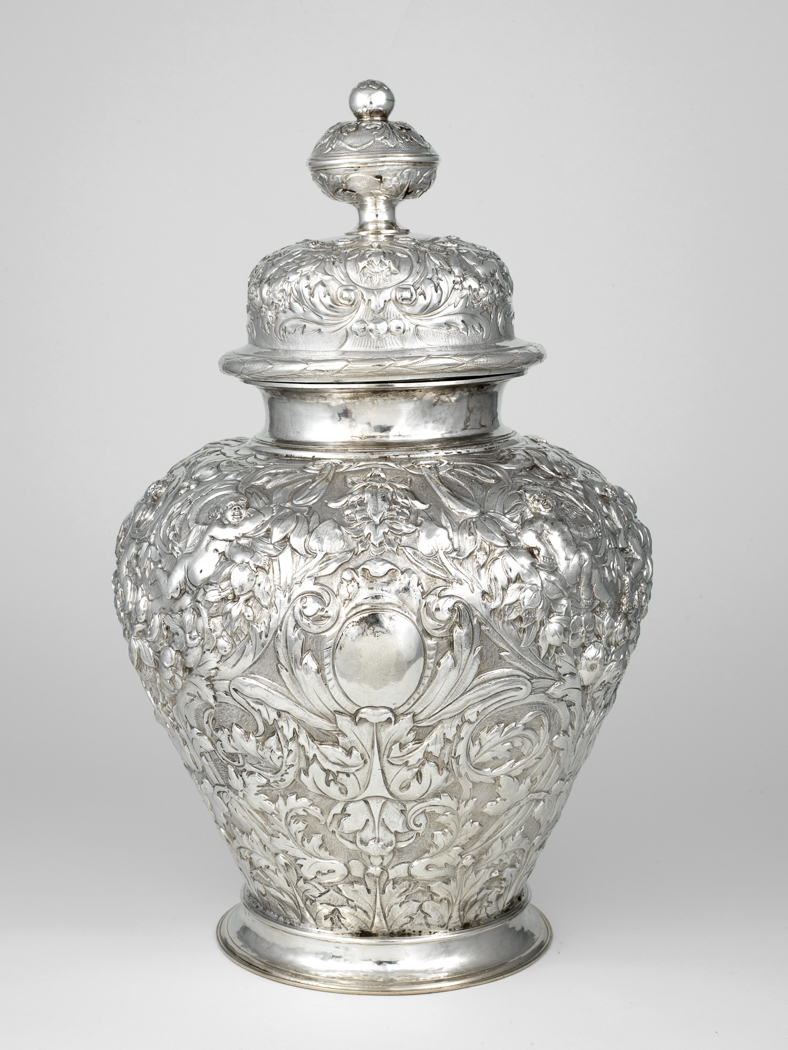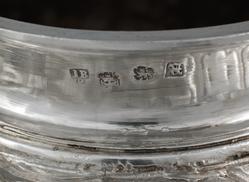Current Location: In storage
Titles
Ginger jar and cover
Maker(s)
Goldsmith:
Bodendeich, Jacob
Entities
Categories
Description
Silver, embossed and chased with putti amongst scrolling foliage against a matted ground; plain neck and foot; replacement knob
Silver, the body and cover embossed, chased, and matted, with applied plain neck and foot. The base is made separately from the sides. Of robust baluster form with incurved neck and foot, domed cover with projecting rim, and a finial comprising a depressed globular knop made in two halves, surmounted by a smaller ball. On three sides of the body there are plain oval cartouches flanked by scrolling foliage. The rest of the surface is decorated in relief with putti amongst scrolling acanthus foliage and flowers against a matted ground. The incurved neck and foot are plain. The projecting edge of the cover is decorated with bound laurel, and the dome with three circular cartouches containing a stylized bud, two of which are flanked by putti with swags below them, and by acanthus foliage which extends round the sides, against a matted ground. In the centre there is a plain silver band from which the finial rises. The depressed globular knop is decorated with upward and downward pointing acanthus foliage, radiating from the bottom and top respectively, and the ball above has a stylized flower on its top.
Notes
History note: Sir Ernest Cassel (1852-1921), Brook House, Mayfair, London; his granddaughter, Lady Edwina Ashley, who married in 1922 Lord Louis Mountbatten; by descent to the vendor from whom purchased through Sotheby's
Legal notes
Purchased with the Cunliffe and Perceval Funds, aided by grants from the National Art Collections Fund and the MLA/V&A Purchase Grant Fund
Measurements and weight
Diameter: 28.5 cm
Diameter: 11¼ in
Height: 46 cm
Height: 18⅛ in
Weight: 2900 g
Weight: 93: 5 oz: dwt
Acquisition and important dates
Method of acquisition: Bought
(2005-07-18)
by
Sotheby's
Dating
17th Century, third quarter
Charles II
Circa
1673
CE
-
1674
CE
Note
Jacob Bodendeich was born at Lüneberg where he served his apprenticeship between 1650 and 1654. He probably came to London at the end of the 1650s and was granted citizenship in 1661. Shortly afterwards he married Susan Mouse, daughter of the goldsmith William Mouse. Bodendeich excelled at chasing and was one of the most talented goldsmiths working in London during the 1660s and 1670s, a period of ostentatious expenditure on furnishings and plate. He registered his mark in May 1664 and was made free of the City of London in August 1673 and of the Goldsmiths’ Company in October 1673. He died in 1681. He signed himself Bodendeich, but his name is sometimes anglicized as Bodendick. The most detailed discussion of his life and work is by Eric J.G. Smith (see Documentation, 2001 and 2002)
Label text from the exhibition ‘Feast and Fast: The Art of Food in Europe, 1500–1800’, on display at The Fitzwilliam Museum from 26 November 2019 until 31 August 2020: Ginger jar and domed cover with putti amongst foliage Although the purpose of Chinese porcelain ‘ginger jars’ remains unclear, their bulbous shape became very fashionable in Europe. Imitations were made in silver during the seventeenth century, such as this one made by the London-based German silversmith, Jacob Bodendeich, and in hard- or soft-paste porcelain in the eighteenth century, purely for decoration.
This ‘ginger jar’ is a handsome example of the silver vases which were displayed on top of cabinets and elsewhere in wealthy households at that time. John Evelyn remarked on the ‘huge Vasas of wrought plate’ in the apartment of the Duchess of Portsmouth in his diary in October 1683. The form was derived from Chinese baluster vases, which often formed the central vase of a garniture of three or more, although the silver versions are usually termed ‘ginger jars’.The decoration of putti amongst foliage was inspired by printed designs such as A New Booke of Foldages by Polifilo Giancarli published by John Overton in 1672, or by the French artist, Jean Lepautre
School or Style
Baroque
People, subjects and objects depicted
Components of the work
Repair
composed of
solder
Jar And Cover
composed of
silver
Vase Mouth
Diameter 15 cm
Diameter 5⅞ in
Cover
Diameter 17 cm
Diameter 6¾ in
Height 16 cm
Height 6¼ in
Weight 510 g
Weight 16: 8 oz: dwt
Vase Foot
Diameter 18.3 cm
Diameter 7¼ in
Vase Only
Height 31 cm
Height 12¼ in
Weight 2390 g
Weight 76: 17 oz: dwt
Body
Decoration
Inscription or legends present
Inscription present: in shield-shaped outline
- Text: I.B a crescent below and two pellets
- Location: On neck
- Method of creation: Struck
- Type: Maker's mark
Inscription present: leopard's head
- Location: On neck
- Method of creation: Struck
- Type: Hallmark
Inscription present: lion passant
- Location: On neck
- Method of creation: Struck
- Type: Hallmark
Inscription present: gothic
- Text: Q
- Location: On neck
- Method of creation: Struck
- Type: Hallmark
Inscription present: circular yellow paper label
- Text: 300
- Location: Inside cover
- Method of creation: Hand-written in black biro
- Type: Label
Inscription present: rectangular pale blue label
- Text: 300
- Location: On base
- Method of creation: Hand-written in blue biro
- Type: Label
References and bibliographic entries
Related exhibitions
Identification numbers
Accession number: M.11 & A-2005
Primary reference Number: 118971
Stable URI
Audit data
Created: Saturday 6 August 2011
Updated: Friday 1 August 2025
Last processed: Friday 1 August 2025
Associated departments & institutions
Owner or interested party:
The Fitzwilliam Museum
Associated department:
Applied Arts

 IIIF Manifest
IIIF Manifest








